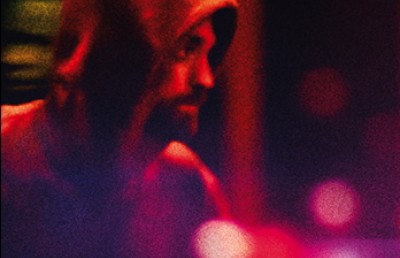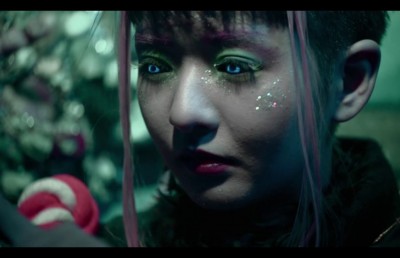A Ghost Story (2017, David Lowery): Grief, Sorrow and Meloncholia
Fantasia 2017, Winner of the Camera Lucida AQCC Prize
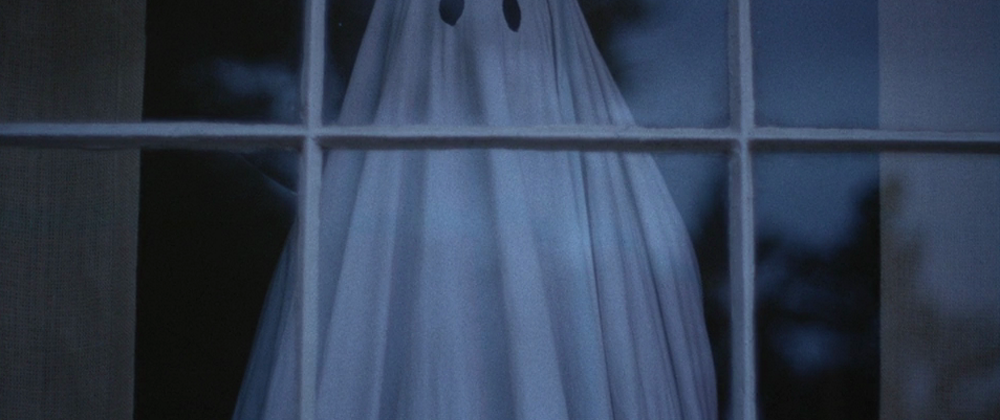
For the majority of its running time, A Ghost Story is told from the point of view of a ghost, a recently dead young musician, played by Casey Affleck, identified only as “C”. Which makes A Ghost Story one of the most original films to have come out of mainstream America in a long time. And a worthy winner of the Jury I was a apart of, the AQCC (“Association québécoise des critiques de cinéma”) Camera Lucida Prize at the Fantasia International Film Festival 2017. The AQCC official release for the prize was given, “For its nuanced cinematic treatment of material and spiritual time across human landscape.” And this from a director whose previous film was Disney’s, Pete’s Dragon (2016). Talk about a change of pace: from Disney to a supernatural ghost story cloaked as an art film.
A Ghost Story is original in multifaceted ways. How else can you explain a film that features two big stars, Rooney Mara and Casey Affleck, with one acting under a white sheet for most of the film and the other largely disappearing from the narrative after about 25 minutes. These type of narrative shifts are not common in mainstream cinema, but perhaps can be expected when made by a director who cites as his direct influences for this film, “Tsai Ming-liang, Apichatpong Weerasethakul and Chantal Akerman”. (Roger Clark)
C and M play a couple recently moved into a reclusive home in Fort Worth, Texas. He likes the tranquil digs, she does not. A little bit like the Stephen King novella 1922, where a rural farming family is forever destroyed when the domestic tensions between the man who loves farm life and the woman who wants to sell and move to the city, lead to murder and supernatural retribution (the novella was adapted into an excellent film by Zak Hilditch in 2017). A Ghost Story opens with a high angle shot of the couple lying together on the couch. The rounded edges of its 4:3 frame suggests or tries to fool us into thinking we are in another reality horror or found footage film, but it denies us this easy reading. And after a few exposition scenes we cut to an overhead shot of the couple in bed caressing and then to an extreme long shot of the house from the street, the camera tracking slowly laterally as M drags a heavy trunk to the curb. After a few more exposition domestic scenes we cut back to them framed overhead in bed embracing and kissing (same day? another day?) only to cut again to the extreme view of the house, smoke sweeping into view, only now the camera pans right to frame the source of the off-frame smoke: a car crash, in which C is a fatal victim. The camera tracks laterally and stops at the car crash, with Affleck flung head forward on the steering wheel. He is dead. M will get her wish of moving to the city, but with a heavy price to pay: grief. Next scene is in a hospital morgue, camera again from afar as M identifies the body. She leaves the room but the camera remains static, with its boxy old school 4:3 framing, long enough for the corpse to surprisingly stoop up. The last time I remember a figure in the background popping up unexpectedly was in 1978’s Halloween (and there too the figure appeared in one scene at least, wearing a white bed sheet). Only here the affect is not to induce fear or anxiety over the well-being of a character, but curiosity. A Ghost Story has the trappings of a horror film but never really strives to horrify.
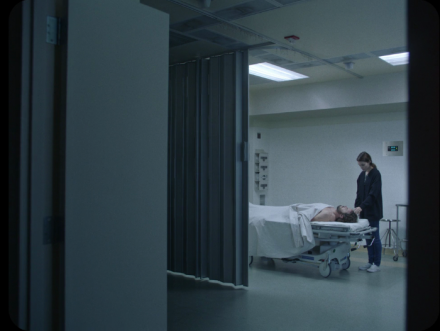
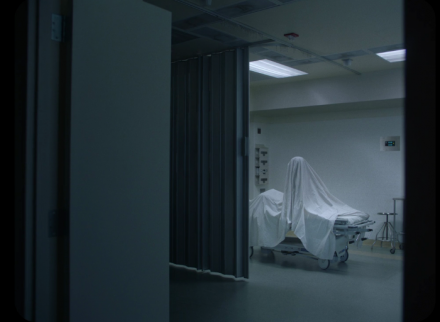
From this point on we assume the feelings of the ghost, as much as those of the grieving wife, who wanders ‘ghost-like’ out of the hospital, with no one taking notice. While the framing is limiting our sense of space and place, the lighting, as it is throughout the film, is wonderfully evocative of mood and emotion, painterly really (see the Rembrandt-like lighting and coloring in the image further below featuring Affleck and his ghost).
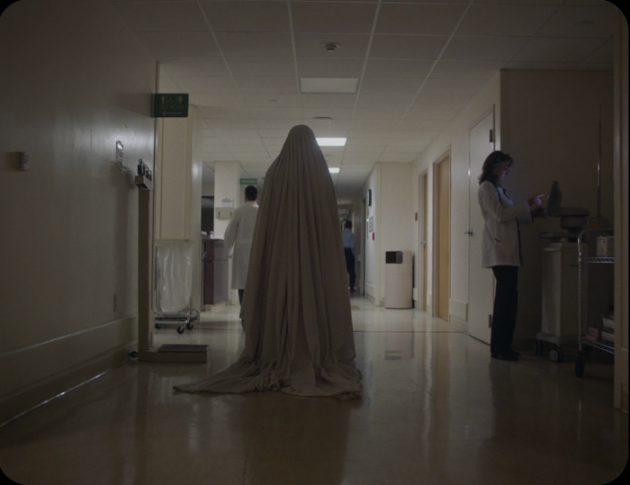
The narrative assumes the wandering timelessness of the ghost, who is not bound by any laws of time (but to some extent, those of space). When Mara is still in the picture the narrative is more grounded. A woman, the real estate agent (whom we see later in one of the ghost’s ‘ungrounded’ memories) drops off a note and pie for the grieving Mara. Mara returns and spends two excruciatingly long static takes, one at the counter where the pie was placed, and the other on the kitchen floor, eating the pie right out of its plate, as a symptom of her grief, then rushing off to the toilet to vomit. All the while I can only think, what kind of pie is it (the camera too far to tell)? And seeing how slim Mara is, wondering how many takes they needed for this scene? How many pies did Mara have to eat? In the second long take M is on the floor on the lower left of the frame and the ghost is in the extreme right background, still, watching her eat. The second take must last close to five minutes and would not look out of place in a Tarkovsky or Sokurov film.
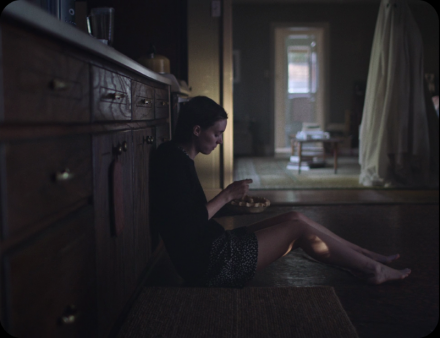
The ghost’s uprooted relationship to time is depicted in the condensed way he sees his wife leaving the house morning after morning moving from one room to the front door, repeating the movement three straight times, a la Ground Hog Day, but in real time (the credits list two Mara body doubles so the shot was taken live in real time, without trickery). The grounding of the story with M proceeds in one scene where it intercuts between a flashback where he makes M listen to his latest indie-rock composition, and M in the present listening to the same song. Soon after this scene M makes a hole in a wall, hides a note there and patches up the hole, then leaves the film for good, leaving us in the hands of an emotive white sheet.
From this point on the film gets experimental in its narrative and temporality. We now become privy to the life of a ghost. What does a ghost do all day long in an empty home? Are ghosts imprisoned where they died. Or in the last home they lived in when they died? The ghost can not follow M toward the rest of her life, but remains slave of his memories, scratching the wall where the note is hidden, calmly staring out the window. In one brilliant moment [[And a fantastic example for my ‘faces in the window’ concept, subject of this audio-visual essay: http://offscreen.com/view/the-face-at-the-window-a-glimpse-into-an-iconic-image he looks out the window to the house across the yard and sees another white sheeted ghost at the other window. They wave. They communicate, silently in sub-titles:
Other Ghost: “Hello”
C: “Hi.”
SG: “I’m waiting for someone.”
C: “Who?”
SG: “I don’t remember.”
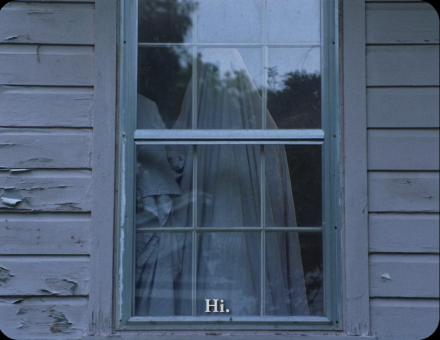
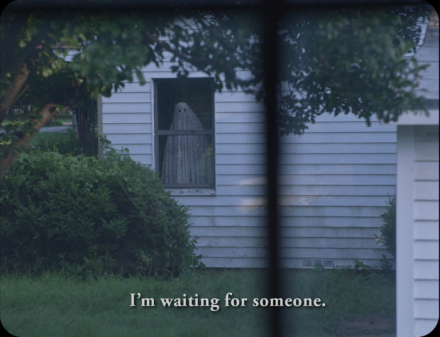
The camera slowly zooms out from C, while a sad score that resembles “Stairway to Heaven” plays on the soundtrack. A ghost (female we assume based on the floral patterns on her white sheet) that has been trapped in that home so long she has forgotten who it was she loved. Can death be more tragic than this? This is the kind of melancholia that the film lives in. In another great touch, the ghost becomes present outside of himself when we see the moment of M leaving for a second time and this time his ‘memory’ of it contains his own image in it, so we see the ghost watching himself AND M.
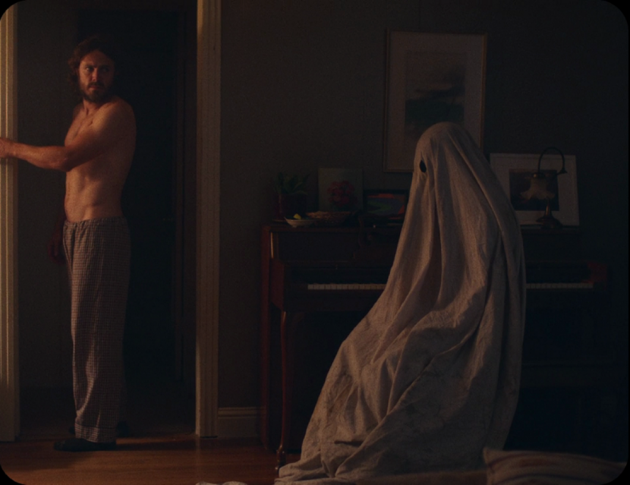
The first family that moves in to their former home after his death and M’s move is a Spanish mother with three kids. They speak Spanish but are NOT subtitled. The ghost seems agitated, as he was when he saw M briefly caress and kiss another man. Something about this family, maybe because of the kids, or maybe because this was soon after his death, or because he does not understand Spanish, makes him frighten them into leaving by violently throwing cutlery onto the floor.
The next moment in the house is a young adult house party with the clothes and attitude suggesting the 1970s. One party-goer responds to woman’s admission of working on a book with a long, captivating discourse on the relativity of everything in life and how even life affirming, spiritual art in the end makes little difference in the grand scheme of things because, as a form of materiality, her book, and ALL things, will eventually disappear from earth…. as indeed will earth itself. Indirectly this single most involved piece of script speaks volumes on the film’s theme: the inevitability of death, the finite nature of legacy and how we can only strive to give meaning to our life, but not certainty or immortality. The philosophically inclined man talks about how the world we know it will change and when it does, who if anyone will remember Beethoven’s 9th symphony? It is a perfect mise en abyme, as this is what we see transpire in front of the ghost’s eyes.
After this time frame, circa the 1970s, the ghost is rudely awakened by a tractor demolishing not only his house but the one where the other ghost lives. In another great image, the two sad ghosts stand next to their respective rubbles. The second ghost grabs at something in the rubble and tells C, “they are not coming back” and then leaves this world forever in a puff of smoke, with her sheet crumbling to the ground lifeless, weightless. The homes are replaced by a land developer into a huge business complex (we see his sheet turn dirty grey, a subtle environmental message?). The ghost now wanders among these corporate lugs in a boardroom, looking out of place.
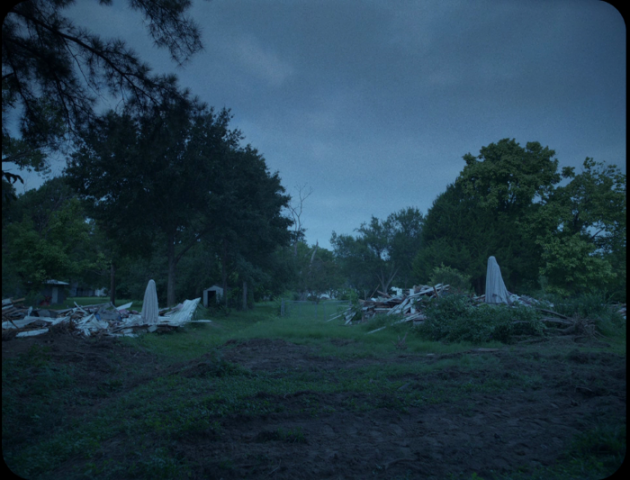
Can we speak about great acting when the actor has a white sheet over his whole body, with two large eye holes? M’s performance recalls other great “monsters” who were encumbered with heavy makeup or without voice yet who still managed to evoke emotion, like Boris Karloff in Frankenstein, Edith Scob in Les Yeux sans visage, Tony Moran as Michael Myers in Halloween and Gunnar Hansen as Leatherface in The Texas Chainsaw Massacre. Much of this has to do with the audience’s reading into the ghost’s blank stare. Director Lowrey admits that much work went into the design of the sheet and its eyes, crediting costume designer Annell Brodeur in a Sight & Sound article by Philip Concannon: “The ghost costume incorporates a helmet and a number of layers, and most importantly, two holes over a black screen that hang in just the right way, giving his blank visage an inherently melancholy quality” (p. 30). This might recall the classic Kuleshov montage experiment, where the same close-up of an emotionless actor is read by the audience to express a different emotion dependent on the shots that follow or proceed it.
The first time we see the ghost I thought of the scene in Halloween where Michael Myers dons the ghost sheet after killing someone in the bedroom. Afflect spends much of the time standing still, but also walks, floats, cranes his neck, his performance becomes one of reaction and a performance which gives the audience much to do. He becomes a walking testament to Kuleshov’s theory of editing. Keep it neutral, blank, and the viewer will do all the emoting. He has so little to go on it makes Karloff’s performance as the Frankenstein monster seem absolutely theatrical!
The modern building complex gives over to a future world of glittering lights, huge skyscrapers and shimmering neon facades. The ghost leans over the edge and throws himself over, only to wake up in the same space (we assume) but centuries earlier, surrounded by a family of pilgrims, evoking, in reverse, Kubrick’s famous “60 million year’ edit in 2001: A Space Odyssey. We even get a classic Western shot of the ghost framed in glorious low angle against a majestic blue sky! Moments later we hear off-screen sounds of Native Americans attacking (or I should say, stereotypical sounds of Hollywood ‘Indians’), then cut back to the family lying dead among their newly minted land, arrows pinned into each of their bodies. C stares at the aftermath, and we can’t tell whether he fully understands what he has witnessed. Successive shots jump ahead in time to reveal the corpses eroding into skeletal form, a direct correlative to the hipster’s earlier treatise on the relativity of “material things”. This temporal pull back to the past raises the sort of questions not asked in conventional ghost films. Why does the ghost have the ability to see the past? Is this a condition of being dead, to become your own time machine? The film now closes back in on itself, as the ghost sees a real estate agent –the woman who dropped off the pie– show the empty house to his former self and M. Now he has literally stepped outside of human time, his own human time, as he watches the very last moments of their life together. We see him sit angrily on the piano, and then see a replay of the early scene when a sound startled them from their sleep. The moment of his own death is elided, and he sees himself seeing M leave for the last time. The house is once again empty. He returns to the note hidden by M and extracts it from the crevice. The moment after he reads it –we never see what is written on the note– he vanishes in a puff of air, like the other ghost. The note must have made clear to him that M is no longer thinking about him. This is the only place where the film follows rather than leads convention: the ghost who haunts the human world for as long as they remain discontent.
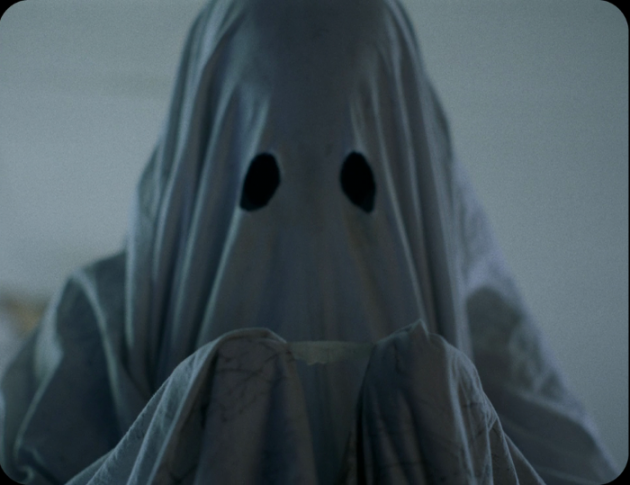
A Ghost Story is a remarkable film in the way it builds thematically to become so much more than just a ghost story. Is it a horror film, if its intent is rarely to scare us? Is dread enough to qualify something as horror? I would say yes because horror can and does touch on life’s complexities. Critics who refer to this is a non-horror film or post-horror are just not looking very closely at what horror has already gifted us. Look at Nicolas Roeg’s Don’t Look Now, a film which instills dread rather than fear and a dread of one character’s eventual realization of his own pretanatural abilities. Jack Clayton’s The Innocents plays with a person’s fear of her own mental instability. Or going farther back, Ugetsu, a ghost story with a similar treatment to space, in the way the potter’s physical presence causes a ghost princess and her house to “come to life”. Like in AGS, the ghost in Ugetsu is able to move beyond her own time frame, if only for a short time. Kyoshi Kurosawa’s works have also tended to mix dread and a certain aesthetic ennui with shudders. The Others (Alejandro Amenábar, 2001) is another supernatural film where a stark, sombre mood prevails. Going back further, The Haunting of Julia (1977) also places a central character’s trauma over her dead daughter at the core of her supernatural encounters, overwhelming the film with a mood of melancholia and grief. A horror film that played at Fantasia in 2015 Anguish (Sonny Mallhi) is equally invested developing the theme of teenage depression and alienation as the potential supernatural elements (Mallhi’s follow-up feature Hurt is playing at this year’s Fantasia). Personal Shoppers (Olivier Assayas, 2016) is another recent “horror” film that treats the theme of grief as experienced by people who have extra sensory abilities (two mediums, the character played by Kristen Stewart and her dead brother). In Personal Shoppers the loss of a loved one becomes a trigger to explore the theme of communication: between the dead and the living, between the living and the living, between the dead and the dead. Even the recent success story It Follows challenges the most conventional of conventional horror types, the slasher film, with an aesthetics of ambiguity over the source of the horror. The Carnival of Souls reveals itself through its title, where a doomed woman comes to the realization her ties to the material world are gone. Even a horror film as canonically horrific as The Texas Chainsaw Massacre has its moments of existential creepiness. Horror has always had the potential to be more than just scary. While A Ghost Story is supernatural, it challenges the genre to think beyond the box. It has more of an emotional pull than one of fear. Only dread-inducing in parts, the film is really about grief, loneliness and the inexorability of all matter to eventually pass on. How will people remember us when we are gone? Well? Not well? Not at all? The house itself, or the space where the house resides, is a character in itself, more than the grieving survivor, M. A Ghost Story makes an interesting companion piece to Personal Shopper, where the home where the dead brother and sister lived plays a characterological role. But unlike that film, where the sister craves contact with her brother’s spirit, M in A ghost Story never once seems to be looking for a sign from her dead partner C. Unlike Kristen Stewart’s character Maureen, M is all about accepting the death and moving on. But we spend time only with the ghost, and do not know anything at all about what M does. Where does M go? What future relationships has she nurtured? Ultimately, the viewer is as trapped from knowing these things as the ghost.
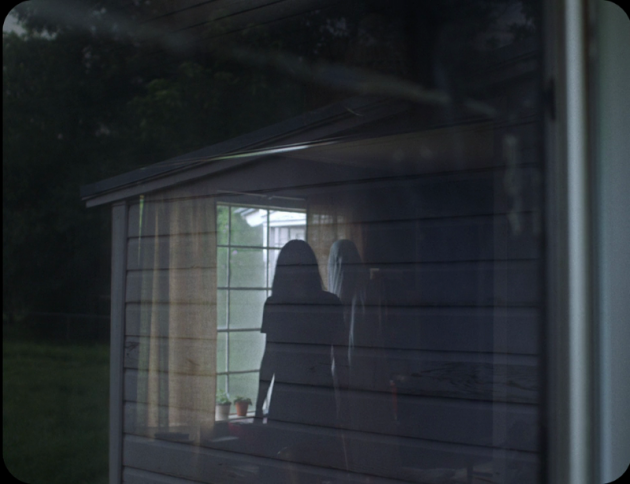
Hard to tell who is the phantom here?
A special mention from AQCC went to Town in a Lake (Matangtubig, 2015, Jet Leyco): “For the facility in which the filmmaker invites the viewer to discover a world progressively veering toward the supernatural.” Click here to read Jordan’s analysis.
Bibliography
Clark, Roger. “A Ghost Story Explores the Delirium of Grief” https://www.bfi.org.uk/news-opinion/sight-sound-magazine/reviews-recommendations/ghost-story-review-david-lowery-casey-affleck-rooney-mara
Interview with Lowery on directing Affleck with ghost sheet: https://www.hollywoodreporter.com/news/a-ghost-story-david-lowery-directing-casey-affleck-under-a-sheet-adding-kesha-cameo-1019245
Concannon, Philp. “Enduring Love.” Sight & Sound. September 2017, p. 28-31.



_400_258_90_s_c1.jpg)
